TB in Hong Kong: Types, Effects, Prevention and Control
VerifiedAdded on 2023/06/15
|12
|4533
|483
AI Summary
This essay discusses the disease tuberculosis, its types, effects, global picture, seriousness, prevention, etc. in the context of Hong Kong. It also covers the services provided to TB patients in Hong Kong.
Contribute Materials
Your contribution can guide someone’s learning journey. Share your
documents today.
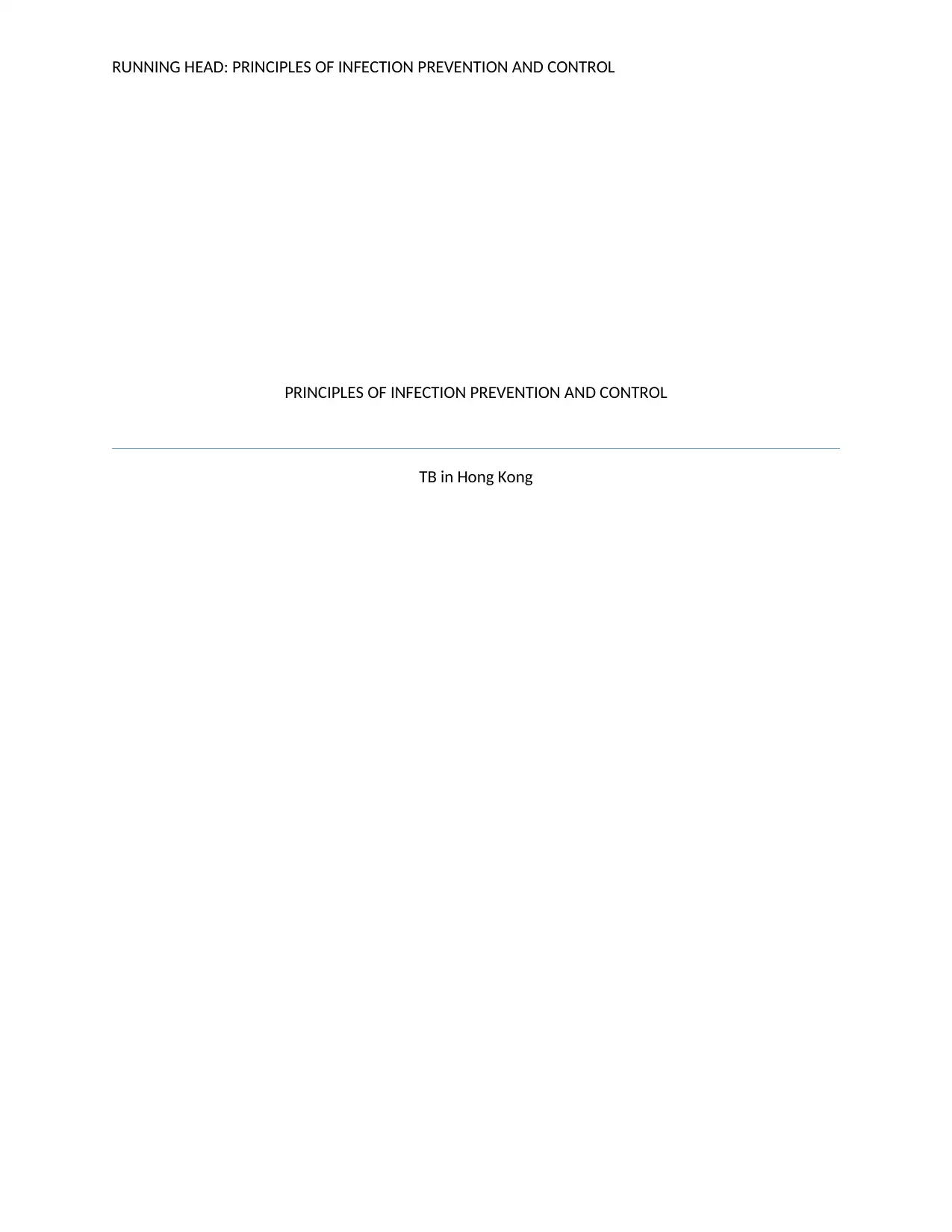
RUNNING HEAD: PRINCIPLES OF INFECTION PREVENTION AND CONTROL
PRINCIPLES OF INFECTION PREVENTION AND CONTROL
TB in Hong Kong
PRINCIPLES OF INFECTION PREVENTION AND CONTROL
TB in Hong Kong
Secure Best Marks with AI Grader
Need help grading? Try our AI Grader for instant feedback on your assignments.
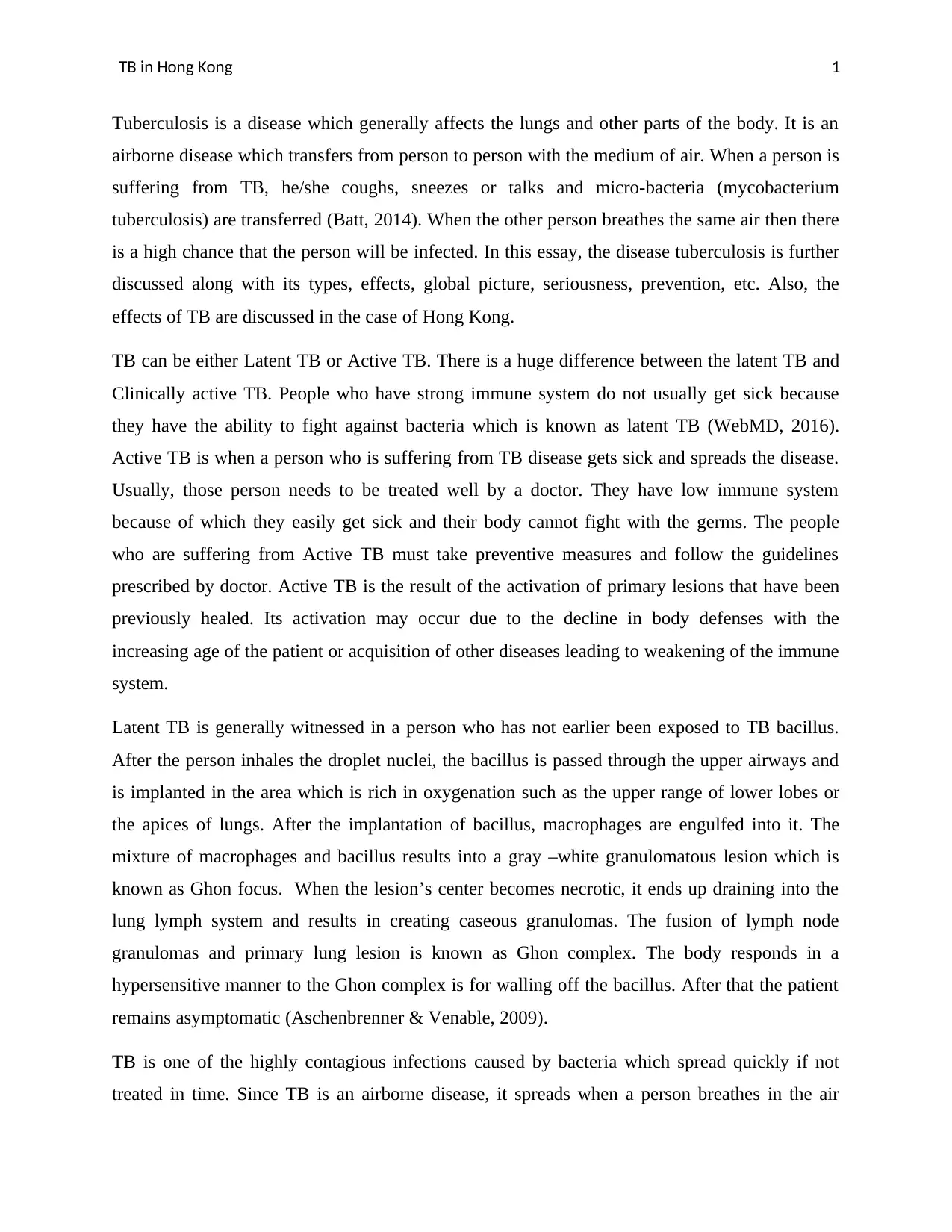
TB in Hong Kong 1
Tuberculosis is a disease which generally affects the lungs and other parts of the body. It is an
airborne disease which transfers from person to person with the medium of air. When a person is
suffering from TB, he/she coughs, sneezes or talks and micro-bacteria (mycobacterium
tuberculosis) are transferred (Batt, 2014). When the other person breathes the same air then there
is a high chance that the person will be infected. In this essay, the disease tuberculosis is further
discussed along with its types, effects, global picture, seriousness, prevention, etc. Also, the
effects of TB are discussed in the case of Hong Kong.
TB can be either Latent TB or Active TB. There is a huge difference between the latent TB and
Clinically active TB. People who have strong immune system do not usually get sick because
they have the ability to fight against bacteria which is known as latent TB (WebMD, 2016).
Active TB is when a person who is suffering from TB disease gets sick and spreads the disease.
Usually, those person needs to be treated well by a doctor. They have low immune system
because of which they easily get sick and their body cannot fight with the germs. The people
who are suffering from Active TB must take preventive measures and follow the guidelines
prescribed by doctor. Active TB is the result of the activation of primary lesions that have been
previously healed. Its activation may occur due to the decline in body defenses with the
increasing age of the patient or acquisition of other diseases leading to weakening of the immune
system.
Latent TB is generally witnessed in a person who has not earlier been exposed to TB bacillus.
After the person inhales the droplet nuclei, the bacillus is passed through the upper airways and
is implanted in the area which is rich in oxygenation such as the upper range of lower lobes or
the apices of lungs. After the implantation of bacillus, macrophages are engulfed into it. The
mixture of macrophages and bacillus results into a gray –white granulomatous lesion which is
known as Ghon focus. When the lesion’s center becomes necrotic, it ends up draining into the
lung lymph system and results in creating caseous granulomas. The fusion of lymph node
granulomas and primary lung lesion is known as Ghon complex. The body responds in a
hypersensitive manner to the Ghon complex is for walling off the bacillus. After that the patient
remains asymptomatic (Aschenbrenner & Venable, 2009).
TB is one of the highly contagious infections caused by bacteria which spread quickly if not
treated in time. Since TB is an airborne disease, it spreads when a person breathes in the air
Tuberculosis is a disease which generally affects the lungs and other parts of the body. It is an
airborne disease which transfers from person to person with the medium of air. When a person is
suffering from TB, he/she coughs, sneezes or talks and micro-bacteria (mycobacterium
tuberculosis) are transferred (Batt, 2014). When the other person breathes the same air then there
is a high chance that the person will be infected. In this essay, the disease tuberculosis is further
discussed along with its types, effects, global picture, seriousness, prevention, etc. Also, the
effects of TB are discussed in the case of Hong Kong.
TB can be either Latent TB or Active TB. There is a huge difference between the latent TB and
Clinically active TB. People who have strong immune system do not usually get sick because
they have the ability to fight against bacteria which is known as latent TB (WebMD, 2016).
Active TB is when a person who is suffering from TB disease gets sick and spreads the disease.
Usually, those person needs to be treated well by a doctor. They have low immune system
because of which they easily get sick and their body cannot fight with the germs. The people
who are suffering from Active TB must take preventive measures and follow the guidelines
prescribed by doctor. Active TB is the result of the activation of primary lesions that have been
previously healed. Its activation may occur due to the decline in body defenses with the
increasing age of the patient or acquisition of other diseases leading to weakening of the immune
system.
Latent TB is generally witnessed in a person who has not earlier been exposed to TB bacillus.
After the person inhales the droplet nuclei, the bacillus is passed through the upper airways and
is implanted in the area which is rich in oxygenation such as the upper range of lower lobes or
the apices of lungs. After the implantation of bacillus, macrophages are engulfed into it. The
mixture of macrophages and bacillus results into a gray –white granulomatous lesion which is
known as Ghon focus. When the lesion’s center becomes necrotic, it ends up draining into the
lung lymph system and results in creating caseous granulomas. The fusion of lymph node
granulomas and primary lung lesion is known as Ghon complex. The body responds in a
hypersensitive manner to the Ghon complex is for walling off the bacillus. After that the patient
remains asymptomatic (Aschenbrenner & Venable, 2009).
TB is one of the highly contagious infections caused by bacteria which spread quickly if not
treated in time. Since TB is an airborne disease, it spreads when a person breathes in the air
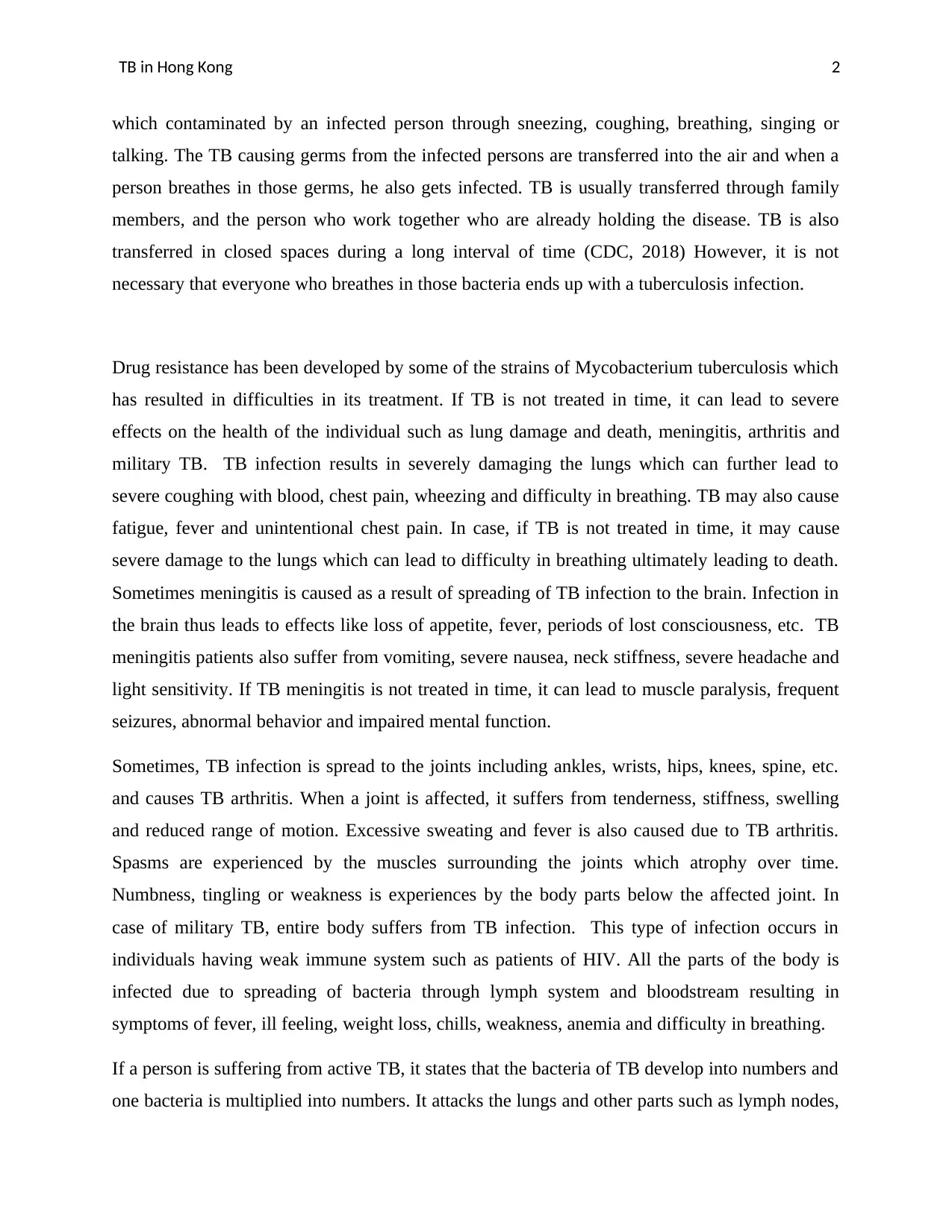
TB in Hong Kong 2
which contaminated by an infected person through sneezing, coughing, breathing, singing or
talking. The TB causing germs from the infected persons are transferred into the air and when a
person breathes in those germs, he also gets infected. TB is usually transferred through family
members, and the person who work together who are already holding the disease. TB is also
transferred in closed spaces during a long interval of time (CDC, 2018) However, it is not
necessary that everyone who breathes in those bacteria ends up with a tuberculosis infection.
Drug resistance has been developed by some of the strains of Mycobacterium tuberculosis which
has resulted in difficulties in its treatment. If TB is not treated in time, it can lead to severe
effects on the health of the individual such as lung damage and death, meningitis, arthritis and
military TB. TB infection results in severely damaging the lungs which can further lead to
severe coughing with blood, chest pain, wheezing and difficulty in breathing. TB may also cause
fatigue, fever and unintentional chest pain. In case, if TB is not treated in time, it may cause
severe damage to the lungs which can lead to difficulty in breathing ultimately leading to death.
Sometimes meningitis is caused as a result of spreading of TB infection to the brain. Infection in
the brain thus leads to effects like loss of appetite, fever, periods of lost consciousness, etc. TB
meningitis patients also suffer from vomiting, severe nausea, neck stiffness, severe headache and
light sensitivity. If TB meningitis is not treated in time, it can lead to muscle paralysis, frequent
seizures, abnormal behavior and impaired mental function.
Sometimes, TB infection is spread to the joints including ankles, wrists, hips, knees, spine, etc.
and causes TB arthritis. When a joint is affected, it suffers from tenderness, stiffness, swelling
and reduced range of motion. Excessive sweating and fever is also caused due to TB arthritis.
Spasms are experienced by the muscles surrounding the joints which atrophy over time.
Numbness, tingling or weakness is experiences by the body parts below the affected joint. In
case of military TB, entire body suffers from TB infection. This type of infection occurs in
individuals having weak immune system such as patients of HIV. All the parts of the body is
infected due to spreading of bacteria through lymph system and bloodstream resulting in
symptoms of fever, ill feeling, weight loss, chills, weakness, anemia and difficulty in breathing.
If a person is suffering from active TB, it states that the bacteria of TB develop into numbers and
one bacteria is multiplied into numbers. It attacks the lungs and other parts such as lymph nodes,
which contaminated by an infected person through sneezing, coughing, breathing, singing or
talking. The TB causing germs from the infected persons are transferred into the air and when a
person breathes in those germs, he also gets infected. TB is usually transferred through family
members, and the person who work together who are already holding the disease. TB is also
transferred in closed spaces during a long interval of time (CDC, 2018) However, it is not
necessary that everyone who breathes in those bacteria ends up with a tuberculosis infection.
Drug resistance has been developed by some of the strains of Mycobacterium tuberculosis which
has resulted in difficulties in its treatment. If TB is not treated in time, it can lead to severe
effects on the health of the individual such as lung damage and death, meningitis, arthritis and
military TB. TB infection results in severely damaging the lungs which can further lead to
severe coughing with blood, chest pain, wheezing and difficulty in breathing. TB may also cause
fatigue, fever and unintentional chest pain. In case, if TB is not treated in time, it may cause
severe damage to the lungs which can lead to difficulty in breathing ultimately leading to death.
Sometimes meningitis is caused as a result of spreading of TB infection to the brain. Infection in
the brain thus leads to effects like loss of appetite, fever, periods of lost consciousness, etc. TB
meningitis patients also suffer from vomiting, severe nausea, neck stiffness, severe headache and
light sensitivity. If TB meningitis is not treated in time, it can lead to muscle paralysis, frequent
seizures, abnormal behavior and impaired mental function.
Sometimes, TB infection is spread to the joints including ankles, wrists, hips, knees, spine, etc.
and causes TB arthritis. When a joint is affected, it suffers from tenderness, stiffness, swelling
and reduced range of motion. Excessive sweating and fever is also caused due to TB arthritis.
Spasms are experienced by the muscles surrounding the joints which atrophy over time.
Numbness, tingling or weakness is experiences by the body parts below the affected joint. In
case of military TB, entire body suffers from TB infection. This type of infection occurs in
individuals having weak immune system such as patients of HIV. All the parts of the body is
infected due to spreading of bacteria through lymph system and bloodstream resulting in
symptoms of fever, ill feeling, weight loss, chills, weakness, anemia and difficulty in breathing.
If a person is suffering from active TB, it states that the bacteria of TB develop into numbers and
one bacteria is multiplied into numbers. It attacks the lungs and other parts such as lymph nodes,
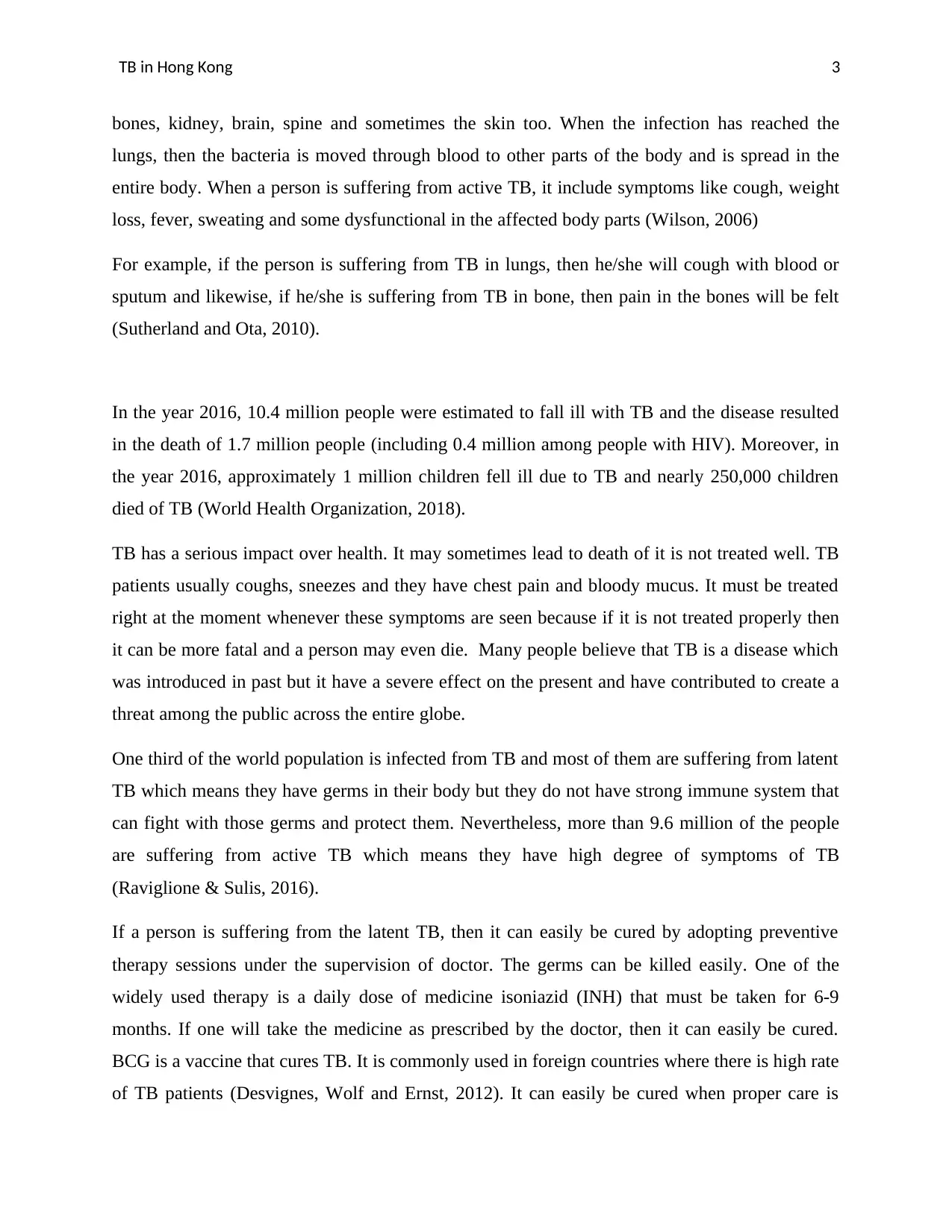
TB in Hong Kong 3
bones, kidney, brain, spine and sometimes the skin too. When the infection has reached the
lungs, then the bacteria is moved through blood to other parts of the body and is spread in the
entire body. When a person is suffering from active TB, it include symptoms like cough, weight
loss, fever, sweating and some dysfunctional in the affected body parts (Wilson, 2006)
For example, if the person is suffering from TB in lungs, then he/she will cough with blood or
sputum and likewise, if he/she is suffering from TB in bone, then pain in the bones will be felt
(Sutherland and Ota, 2010).
In the year 2016, 10.4 million people were estimated to fall ill with TB and the disease resulted
in the death of 1.7 million people (including 0.4 million among people with HIV). Moreover, in
the year 2016, approximately 1 million children fell ill due to TB and nearly 250,000 children
died of TB (World Health Organization, 2018).
TB has a serious impact over health. It may sometimes lead to death of it is not treated well. TB
patients usually coughs, sneezes and they have chest pain and bloody mucus. It must be treated
right at the moment whenever these symptoms are seen because if it is not treated properly then
it can be more fatal and a person may even die. Many people believe that TB is a disease which
was introduced in past but it have a severe effect on the present and have contributed to create a
threat among the public across the entire globe.
One third of the world population is infected from TB and most of them are suffering from latent
TB which means they have germs in their body but they do not have strong immune system that
can fight with those germs and protect them. Nevertheless, more than 9.6 million of the people
are suffering from active TB which means they have high degree of symptoms of TB
(Raviglione & Sulis, 2016).
If a person is suffering from the latent TB, then it can easily be cured by adopting preventive
therapy sessions under the supervision of doctor. The germs can be killed easily. One of the
widely used therapy is a daily dose of medicine isoniazid (INH) that must be taken for 6-9
months. If one will take the medicine as prescribed by the doctor, then it can easily be cured.
BCG is a vaccine that cures TB. It is commonly used in foreign countries where there is high rate
of TB patients (Desvignes, Wolf and Ernst, 2012). It can easily be cured when proper care is
bones, kidney, brain, spine and sometimes the skin too. When the infection has reached the
lungs, then the bacteria is moved through blood to other parts of the body and is spread in the
entire body. When a person is suffering from active TB, it include symptoms like cough, weight
loss, fever, sweating and some dysfunctional in the affected body parts (Wilson, 2006)
For example, if the person is suffering from TB in lungs, then he/she will cough with blood or
sputum and likewise, if he/she is suffering from TB in bone, then pain in the bones will be felt
(Sutherland and Ota, 2010).
In the year 2016, 10.4 million people were estimated to fall ill with TB and the disease resulted
in the death of 1.7 million people (including 0.4 million among people with HIV). Moreover, in
the year 2016, approximately 1 million children fell ill due to TB and nearly 250,000 children
died of TB (World Health Organization, 2018).
TB has a serious impact over health. It may sometimes lead to death of it is not treated well. TB
patients usually coughs, sneezes and they have chest pain and bloody mucus. It must be treated
right at the moment whenever these symptoms are seen because if it is not treated properly then
it can be more fatal and a person may even die. Many people believe that TB is a disease which
was introduced in past but it have a severe effect on the present and have contributed to create a
threat among the public across the entire globe.
One third of the world population is infected from TB and most of them are suffering from latent
TB which means they have germs in their body but they do not have strong immune system that
can fight with those germs and protect them. Nevertheless, more than 9.6 million of the people
are suffering from active TB which means they have high degree of symptoms of TB
(Raviglione & Sulis, 2016).
If a person is suffering from the latent TB, then it can easily be cured by adopting preventive
therapy sessions under the supervision of doctor. The germs can be killed easily. One of the
widely used therapy is a daily dose of medicine isoniazid (INH) that must be taken for 6-9
months. If one will take the medicine as prescribed by the doctor, then it can easily be cured.
BCG is a vaccine that cures TB. It is commonly used in foreign countries where there is high rate
of TB patients (Desvignes, Wolf and Ernst, 2012). It can easily be cured when proper care is
Secure Best Marks with AI Grader
Need help grading? Try our AI Grader for instant feedback on your assignments.
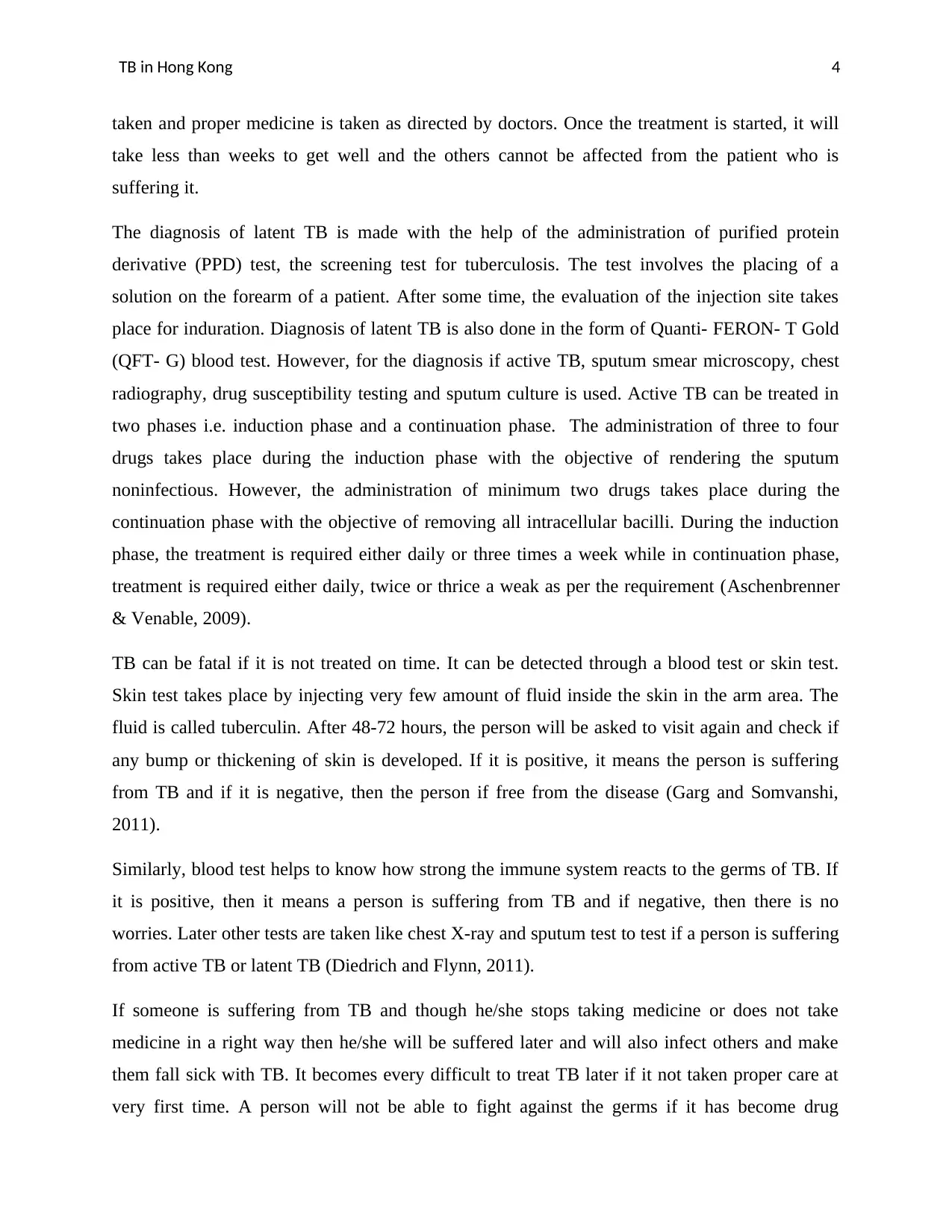
TB in Hong Kong 4
taken and proper medicine is taken as directed by doctors. Once the treatment is started, it will
take less than weeks to get well and the others cannot be affected from the patient who is
suffering it.
The diagnosis of latent TB is made with the help of the administration of purified protein
derivative (PPD) test, the screening test for tuberculosis. The test involves the placing of a
solution on the forearm of a patient. After some time, the evaluation of the injection site takes
place for induration. Diagnosis of latent TB is also done in the form of Quanti- FERON- T Gold
(QFT- G) blood test. However, for the diagnosis if active TB, sputum smear microscopy, chest
radiography, drug susceptibility testing and sputum culture is used. Active TB can be treated in
two phases i.e. induction phase and a continuation phase. The administration of three to four
drugs takes place during the induction phase with the objective of rendering the sputum
noninfectious. However, the administration of minimum two drugs takes place during the
continuation phase with the objective of removing all intracellular bacilli. During the induction
phase, the treatment is required either daily or three times a week while in continuation phase,
treatment is required either daily, twice or thrice a weak as per the requirement (Aschenbrenner
& Venable, 2009).
TB can be fatal if it is not treated on time. It can be detected through a blood test or skin test.
Skin test takes place by injecting very few amount of fluid inside the skin in the arm area. The
fluid is called tuberculin. After 48-72 hours, the person will be asked to visit again and check if
any bump or thickening of skin is developed. If it is positive, it means the person is suffering
from TB and if it is negative, then the person if free from the disease (Garg and Somvanshi,
2011).
Similarly, blood test helps to know how strong the immune system reacts to the germs of TB. If
it is positive, then it means a person is suffering from TB and if negative, then there is no
worries. Later other tests are taken like chest X-ray and sputum test to test if a person is suffering
from active TB or latent TB (Diedrich and Flynn, 2011).
If someone is suffering from TB and though he/she stops taking medicine or does not take
medicine in a right way then he/she will be suffered later and will also infect others and make
them fall sick with TB. It becomes every difficult to treat TB later if it not taken proper care at
very first time. A person will not be able to fight against the germs if it has become drug
taken and proper medicine is taken as directed by doctors. Once the treatment is started, it will
take less than weeks to get well and the others cannot be affected from the patient who is
suffering it.
The diagnosis of latent TB is made with the help of the administration of purified protein
derivative (PPD) test, the screening test for tuberculosis. The test involves the placing of a
solution on the forearm of a patient. After some time, the evaluation of the injection site takes
place for induration. Diagnosis of latent TB is also done in the form of Quanti- FERON- T Gold
(QFT- G) blood test. However, for the diagnosis if active TB, sputum smear microscopy, chest
radiography, drug susceptibility testing and sputum culture is used. Active TB can be treated in
two phases i.e. induction phase and a continuation phase. The administration of three to four
drugs takes place during the induction phase with the objective of rendering the sputum
noninfectious. However, the administration of minimum two drugs takes place during the
continuation phase with the objective of removing all intracellular bacilli. During the induction
phase, the treatment is required either daily or three times a week while in continuation phase,
treatment is required either daily, twice or thrice a weak as per the requirement (Aschenbrenner
& Venable, 2009).
TB can be fatal if it is not treated on time. It can be detected through a blood test or skin test.
Skin test takes place by injecting very few amount of fluid inside the skin in the arm area. The
fluid is called tuberculin. After 48-72 hours, the person will be asked to visit again and check if
any bump or thickening of skin is developed. If it is positive, it means the person is suffering
from TB and if it is negative, then the person if free from the disease (Garg and Somvanshi,
2011).
Similarly, blood test helps to know how strong the immune system reacts to the germs of TB. If
it is positive, then it means a person is suffering from TB and if negative, then there is no
worries. Later other tests are taken like chest X-ray and sputum test to test if a person is suffering
from active TB or latent TB (Diedrich and Flynn, 2011).
If someone is suffering from TB and though he/she stops taking medicine or does not take
medicine in a right way then he/she will be suffered later and will also infect others and make
them fall sick with TB. It becomes every difficult to treat TB later if it not taken proper care at
very first time. A person will not be able to fight against the germs if it has become drug
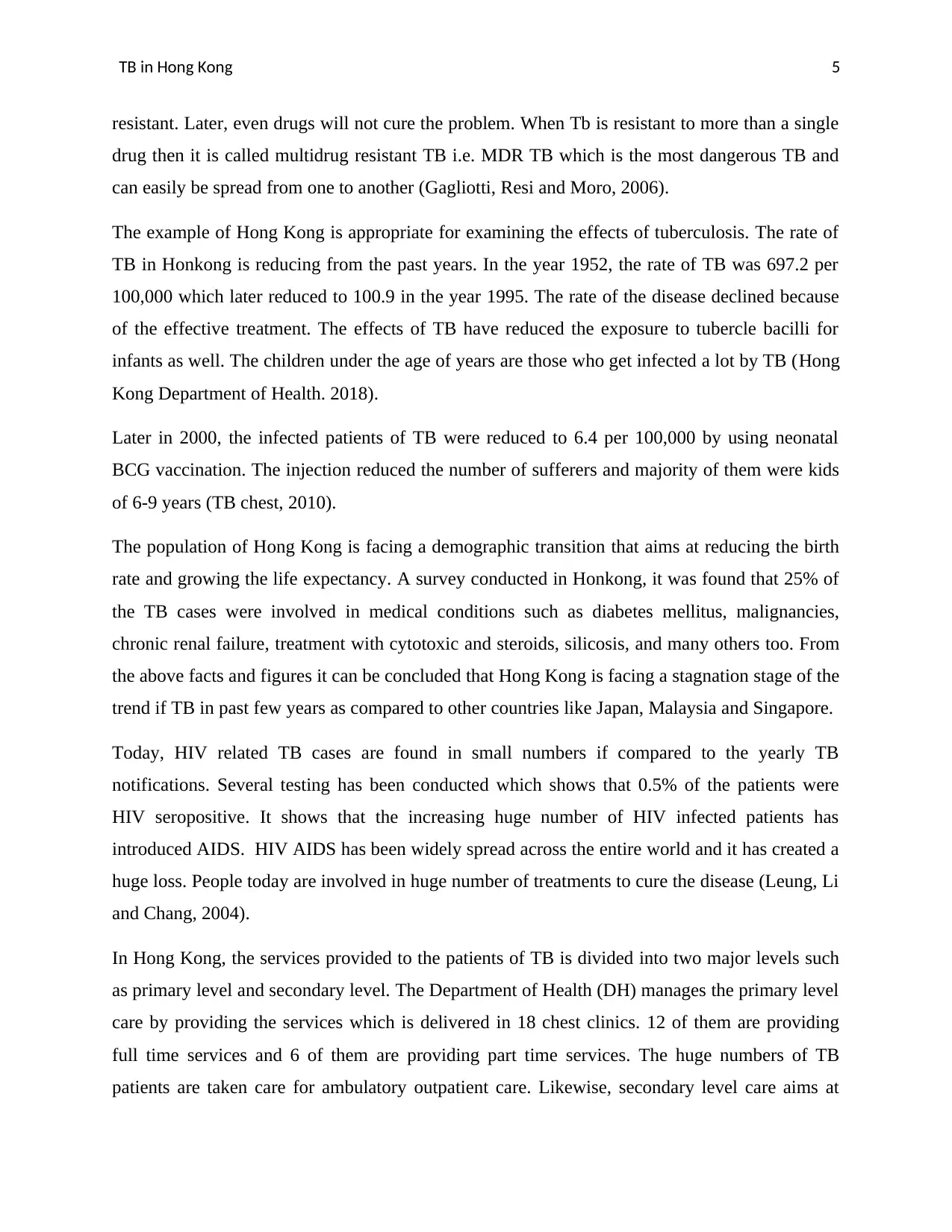
TB in Hong Kong 5
resistant. Later, even drugs will not cure the problem. When Tb is resistant to more than a single
drug then it is called multidrug resistant TB i.e. MDR TB which is the most dangerous TB and
can easily be spread from one to another (Gagliotti, Resi and Moro, 2006).
The example of Hong Kong is appropriate for examining the effects of tuberculosis. The rate of
TB in Honkong is reducing from the past years. In the year 1952, the rate of TB was 697.2 per
100,000 which later reduced to 100.9 in the year 1995. The rate of the disease declined because
of the effective treatment. The effects of TB have reduced the exposure to tubercle bacilli for
infants as well. The children under the age of years are those who get infected a lot by TB (Hong
Kong Department of Health. 2018).
Later in 2000, the infected patients of TB were reduced to 6.4 per 100,000 by using neonatal
BCG vaccination. The injection reduced the number of sufferers and majority of them were kids
of 6-9 years (TB chest, 2010).
The population of Hong Kong is facing a demographic transition that aims at reducing the birth
rate and growing the life expectancy. A survey conducted in Honkong, it was found that 25% of
the TB cases were involved in medical conditions such as diabetes mellitus, malignancies,
chronic renal failure, treatment with cytotoxic and steroids, silicosis, and many others too. From
the above facts and figures it can be concluded that Hong Kong is facing a stagnation stage of the
trend if TB in past few years as compared to other countries like Japan, Malaysia and Singapore.
Today, HIV related TB cases are found in small numbers if compared to the yearly TB
notifications. Several testing has been conducted which shows that 0.5% of the patients were
HIV seropositive. It shows that the increasing huge number of HIV infected patients has
introduced AIDS. HIV AIDS has been widely spread across the entire world and it has created a
huge loss. People today are involved in huge number of treatments to cure the disease (Leung, Li
and Chang, 2004).
In Hong Kong, the services provided to the patients of TB is divided into two major levels such
as primary level and secondary level. The Department of Health (DH) manages the primary level
care by providing the services which is delivered in 18 chest clinics. 12 of them are providing
full time services and 6 of them are providing part time services. The huge numbers of TB
patients are taken care for ambulatory outpatient care. Likewise, secondary level care aims at
resistant. Later, even drugs will not cure the problem. When Tb is resistant to more than a single
drug then it is called multidrug resistant TB i.e. MDR TB which is the most dangerous TB and
can easily be spread from one to another (Gagliotti, Resi and Moro, 2006).
The example of Hong Kong is appropriate for examining the effects of tuberculosis. The rate of
TB in Honkong is reducing from the past years. In the year 1952, the rate of TB was 697.2 per
100,000 which later reduced to 100.9 in the year 1995. The rate of the disease declined because
of the effective treatment. The effects of TB have reduced the exposure to tubercle bacilli for
infants as well. The children under the age of years are those who get infected a lot by TB (Hong
Kong Department of Health. 2018).
Later in 2000, the infected patients of TB were reduced to 6.4 per 100,000 by using neonatal
BCG vaccination. The injection reduced the number of sufferers and majority of them were kids
of 6-9 years (TB chest, 2010).
The population of Hong Kong is facing a demographic transition that aims at reducing the birth
rate and growing the life expectancy. A survey conducted in Honkong, it was found that 25% of
the TB cases were involved in medical conditions such as diabetes mellitus, malignancies,
chronic renal failure, treatment with cytotoxic and steroids, silicosis, and many others too. From
the above facts and figures it can be concluded that Hong Kong is facing a stagnation stage of the
trend if TB in past few years as compared to other countries like Japan, Malaysia and Singapore.
Today, HIV related TB cases are found in small numbers if compared to the yearly TB
notifications. Several testing has been conducted which shows that 0.5% of the patients were
HIV seropositive. It shows that the increasing huge number of HIV infected patients has
introduced AIDS. HIV AIDS has been widely spread across the entire world and it has created a
huge loss. People today are involved in huge number of treatments to cure the disease (Leung, Li
and Chang, 2004).
In Hong Kong, the services provided to the patients of TB is divided into two major levels such
as primary level and secondary level. The Department of Health (DH) manages the primary level
care by providing the services which is delivered in 18 chest clinics. 12 of them are providing
full time services and 6 of them are providing part time services. The huge numbers of TB
patients are taken care for ambulatory outpatient care. Likewise, secondary level care aims at
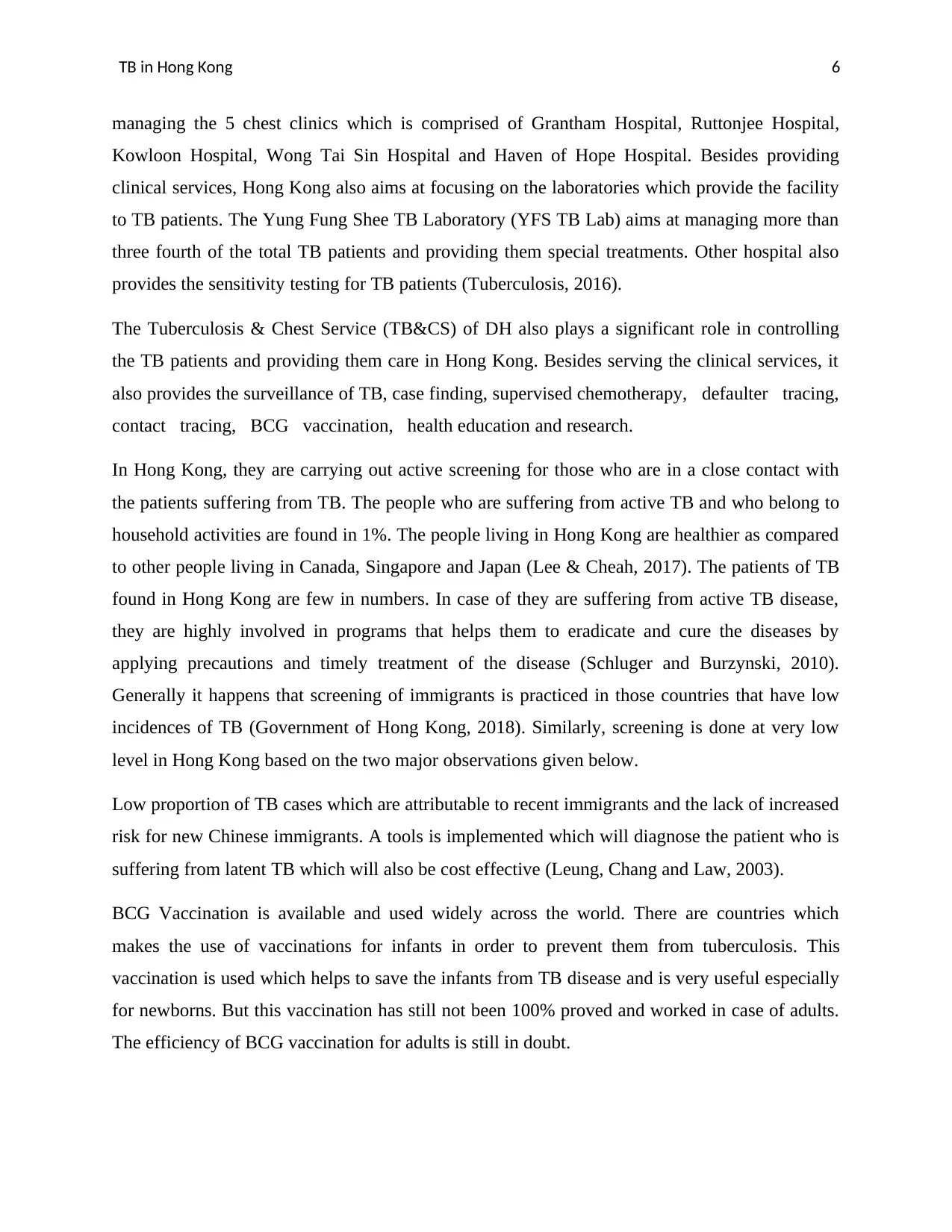
TB in Hong Kong 6
managing the 5 chest clinics which is comprised of Grantham Hospital, Ruttonjee Hospital,
Kowloon Hospital, Wong Tai Sin Hospital and Haven of Hope Hospital. Besides providing
clinical services, Hong Kong also aims at focusing on the laboratories which provide the facility
to TB patients. The Yung Fung Shee TB Laboratory (YFS TB Lab) aims at managing more than
three fourth of the total TB patients and providing them special treatments. Other hospital also
provides the sensitivity testing for TB patients (Tuberculosis, 2016).
The Tuberculosis & Chest Service (TB&CS) of DH also plays a significant role in controlling
the TB patients and providing them care in Hong Kong. Besides serving the clinical services, it
also provides the surveillance of TB, case finding, supervised chemotherapy, defaulter tracing,
contact tracing, BCG vaccination, health education and research.
In Hong Kong, they are carrying out active screening for those who are in a close contact with
the patients suffering from TB. The people who are suffering from active TB and who belong to
household activities are found in 1%. The people living in Hong Kong are healthier as compared
to other people living in Canada, Singapore and Japan (Lee & Cheah, 2017). The patients of TB
found in Hong Kong are few in numbers. In case of they are suffering from active TB disease,
they are highly involved in programs that helps them to eradicate and cure the diseases by
applying precautions and timely treatment of the disease (Schluger and Burzynski, 2010).
Generally it happens that screening of immigrants is practiced in those countries that have low
incidences of TB (Government of Hong Kong, 2018). Similarly, screening is done at very low
level in Hong Kong based on the two major observations given below.
Low proportion of TB cases which are attributable to recent immigrants and the lack of increased
risk for new Chinese immigrants. A tools is implemented which will diagnose the patient who is
suffering from latent TB which will also be cost effective (Leung, Chang and Law, 2003).
BCG Vaccination is available and used widely across the world. There are countries which
makes the use of vaccinations for infants in order to prevent them from tuberculosis. This
vaccination is used which helps to save the infants from TB disease and is very useful especially
for newborns. But this vaccination has still not been 100% proved and worked in case of adults.
The efficiency of BCG vaccination for adults is still in doubt.
managing the 5 chest clinics which is comprised of Grantham Hospital, Ruttonjee Hospital,
Kowloon Hospital, Wong Tai Sin Hospital and Haven of Hope Hospital. Besides providing
clinical services, Hong Kong also aims at focusing on the laboratories which provide the facility
to TB patients. The Yung Fung Shee TB Laboratory (YFS TB Lab) aims at managing more than
three fourth of the total TB patients and providing them special treatments. Other hospital also
provides the sensitivity testing for TB patients (Tuberculosis, 2016).
The Tuberculosis & Chest Service (TB&CS) of DH also plays a significant role in controlling
the TB patients and providing them care in Hong Kong. Besides serving the clinical services, it
also provides the surveillance of TB, case finding, supervised chemotherapy, defaulter tracing,
contact tracing, BCG vaccination, health education and research.
In Hong Kong, they are carrying out active screening for those who are in a close contact with
the patients suffering from TB. The people who are suffering from active TB and who belong to
household activities are found in 1%. The people living in Hong Kong are healthier as compared
to other people living in Canada, Singapore and Japan (Lee & Cheah, 2017). The patients of TB
found in Hong Kong are few in numbers. In case of they are suffering from active TB disease,
they are highly involved in programs that helps them to eradicate and cure the diseases by
applying precautions and timely treatment of the disease (Schluger and Burzynski, 2010).
Generally it happens that screening of immigrants is practiced in those countries that have low
incidences of TB (Government of Hong Kong, 2018). Similarly, screening is done at very low
level in Hong Kong based on the two major observations given below.
Low proportion of TB cases which are attributable to recent immigrants and the lack of increased
risk for new Chinese immigrants. A tools is implemented which will diagnose the patient who is
suffering from latent TB which will also be cost effective (Leung, Chang and Law, 2003).
BCG Vaccination is available and used widely across the world. There are countries which
makes the use of vaccinations for infants in order to prevent them from tuberculosis. This
vaccination is used which helps to save the infants from TB disease and is very useful especially
for newborns. But this vaccination has still not been 100% proved and worked in case of adults.
The efficiency of BCG vaccination for adults is still in doubt.
Paraphrase This Document
Need a fresh take? Get an instant paraphrase of this document with our AI Paraphraser
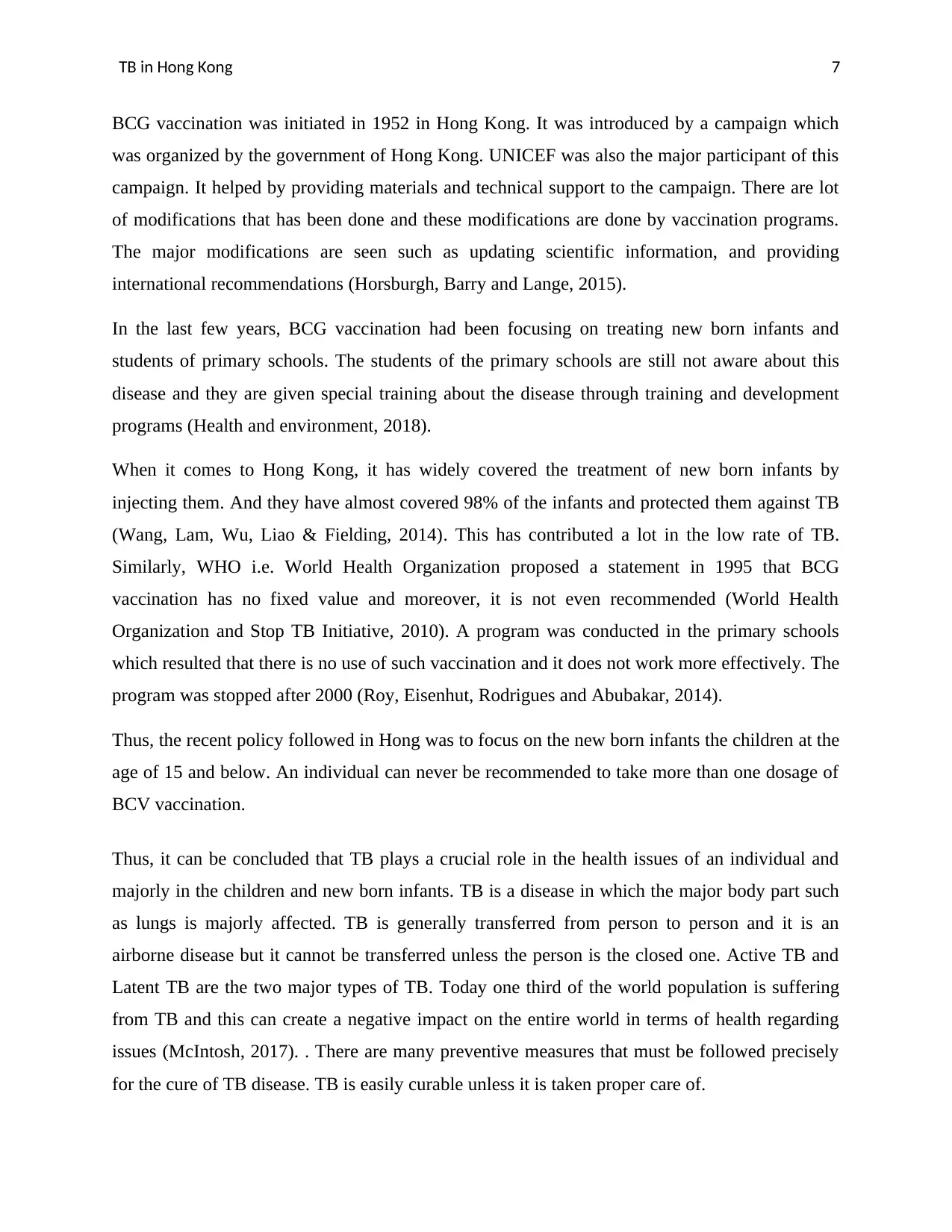
TB in Hong Kong 7
BCG vaccination was initiated in 1952 in Hong Kong. It was introduced by a campaign which
was organized by the government of Hong Kong. UNICEF was also the major participant of this
campaign. It helped by providing materials and technical support to the campaign. There are lot
of modifications that has been done and these modifications are done by vaccination programs.
The major modifications are seen such as updating scientific information, and providing
international recommendations (Horsburgh, Barry and Lange, 2015).
In the last few years, BCG vaccination had been focusing on treating new born infants and
students of primary schools. The students of the primary schools are still not aware about this
disease and they are given special training about the disease through training and development
programs (Health and environment, 2018).
When it comes to Hong Kong, it has widely covered the treatment of new born infants by
injecting them. And they have almost covered 98% of the infants and protected them against TB
(Wang, Lam, Wu, Liao & Fielding, 2014). This has contributed a lot in the low rate of TB.
Similarly, WHO i.e. World Health Organization proposed a statement in 1995 that BCG
vaccination has no fixed value and moreover, it is not even recommended (World Health
Organization and Stop TB Initiative, 2010). A program was conducted in the primary schools
which resulted that there is no use of such vaccination and it does not work more effectively. The
program was stopped after 2000 (Roy, Eisenhut, Rodrigues and Abubakar, 2014).
Thus, the recent policy followed in Hong was to focus on the new born infants the children at the
age of 15 and below. An individual can never be recommended to take more than one dosage of
BCV vaccination.
Thus, it can be concluded that TB plays a crucial role in the health issues of an individual and
majorly in the children and new born infants. TB is a disease in which the major body part such
as lungs is majorly affected. TB is generally transferred from person to person and it is an
airborne disease but it cannot be transferred unless the person is the closed one. Active TB and
Latent TB are the two major types of TB. Today one third of the world population is suffering
from TB and this can create a negative impact on the entire world in terms of health regarding
issues (McIntosh, 2017). . There are many preventive measures that must be followed precisely
for the cure of TB disease. TB is easily curable unless it is taken proper care of.
BCG vaccination was initiated in 1952 in Hong Kong. It was introduced by a campaign which
was organized by the government of Hong Kong. UNICEF was also the major participant of this
campaign. It helped by providing materials and technical support to the campaign. There are lot
of modifications that has been done and these modifications are done by vaccination programs.
The major modifications are seen such as updating scientific information, and providing
international recommendations (Horsburgh, Barry and Lange, 2015).
In the last few years, BCG vaccination had been focusing on treating new born infants and
students of primary schools. The students of the primary schools are still not aware about this
disease and they are given special training about the disease through training and development
programs (Health and environment, 2018).
When it comes to Hong Kong, it has widely covered the treatment of new born infants by
injecting them. And they have almost covered 98% of the infants and protected them against TB
(Wang, Lam, Wu, Liao & Fielding, 2014). This has contributed a lot in the low rate of TB.
Similarly, WHO i.e. World Health Organization proposed a statement in 1995 that BCG
vaccination has no fixed value and moreover, it is not even recommended (World Health
Organization and Stop TB Initiative, 2010). A program was conducted in the primary schools
which resulted that there is no use of such vaccination and it does not work more effectively. The
program was stopped after 2000 (Roy, Eisenhut, Rodrigues and Abubakar, 2014).
Thus, the recent policy followed in Hong was to focus on the new born infants the children at the
age of 15 and below. An individual can never be recommended to take more than one dosage of
BCV vaccination.
Thus, it can be concluded that TB plays a crucial role in the health issues of an individual and
majorly in the children and new born infants. TB is a disease in which the major body part such
as lungs is majorly affected. TB is generally transferred from person to person and it is an
airborne disease but it cannot be transferred unless the person is the closed one. Active TB and
Latent TB are the two major types of TB. Today one third of the world population is suffering
from TB and this can create a negative impact on the entire world in terms of health regarding
issues (McIntosh, 2017). . There are many preventive measures that must be followed precisely
for the cure of TB disease. TB is easily curable unless it is taken proper care of.
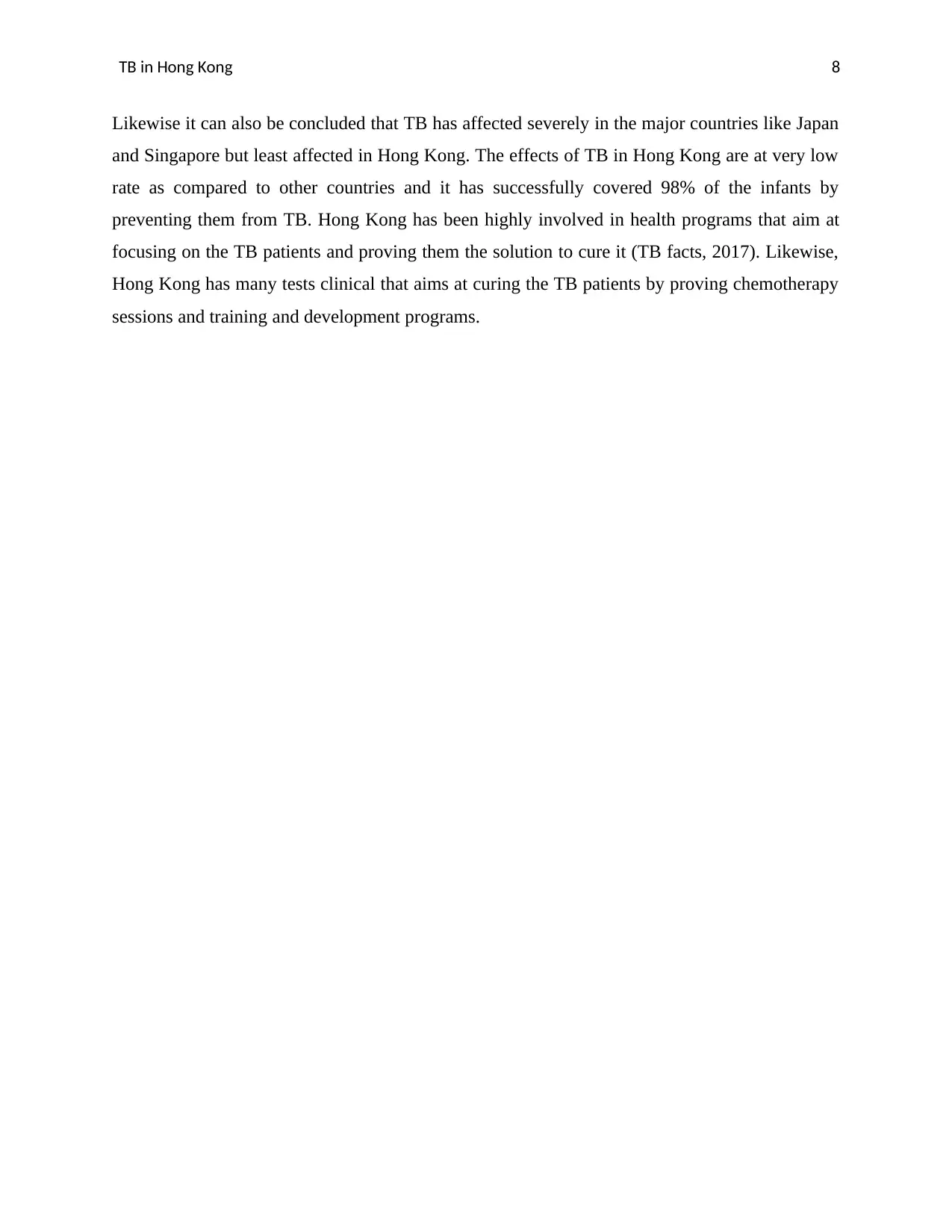
TB in Hong Kong 8
Likewise it can also be concluded that TB has affected severely in the major countries like Japan
and Singapore but least affected in Hong Kong. The effects of TB in Hong Kong are at very low
rate as compared to other countries and it has successfully covered 98% of the infants by
preventing them from TB. Hong Kong has been highly involved in health programs that aim at
focusing on the TB patients and proving them the solution to cure it (TB facts, 2017). Likewise,
Hong Kong has many tests clinical that aims at curing the TB patients by proving chemotherapy
sessions and training and development programs.
Likewise it can also be concluded that TB has affected severely in the major countries like Japan
and Singapore but least affected in Hong Kong. The effects of TB in Hong Kong are at very low
rate as compared to other countries and it has successfully covered 98% of the infants by
preventing them from TB. Hong Kong has been highly involved in health programs that aim at
focusing on the TB patients and proving them the solution to cure it (TB facts, 2017). Likewise,
Hong Kong has many tests clinical that aims at curing the TB patients by proving chemotherapy
sessions and training and development programs.
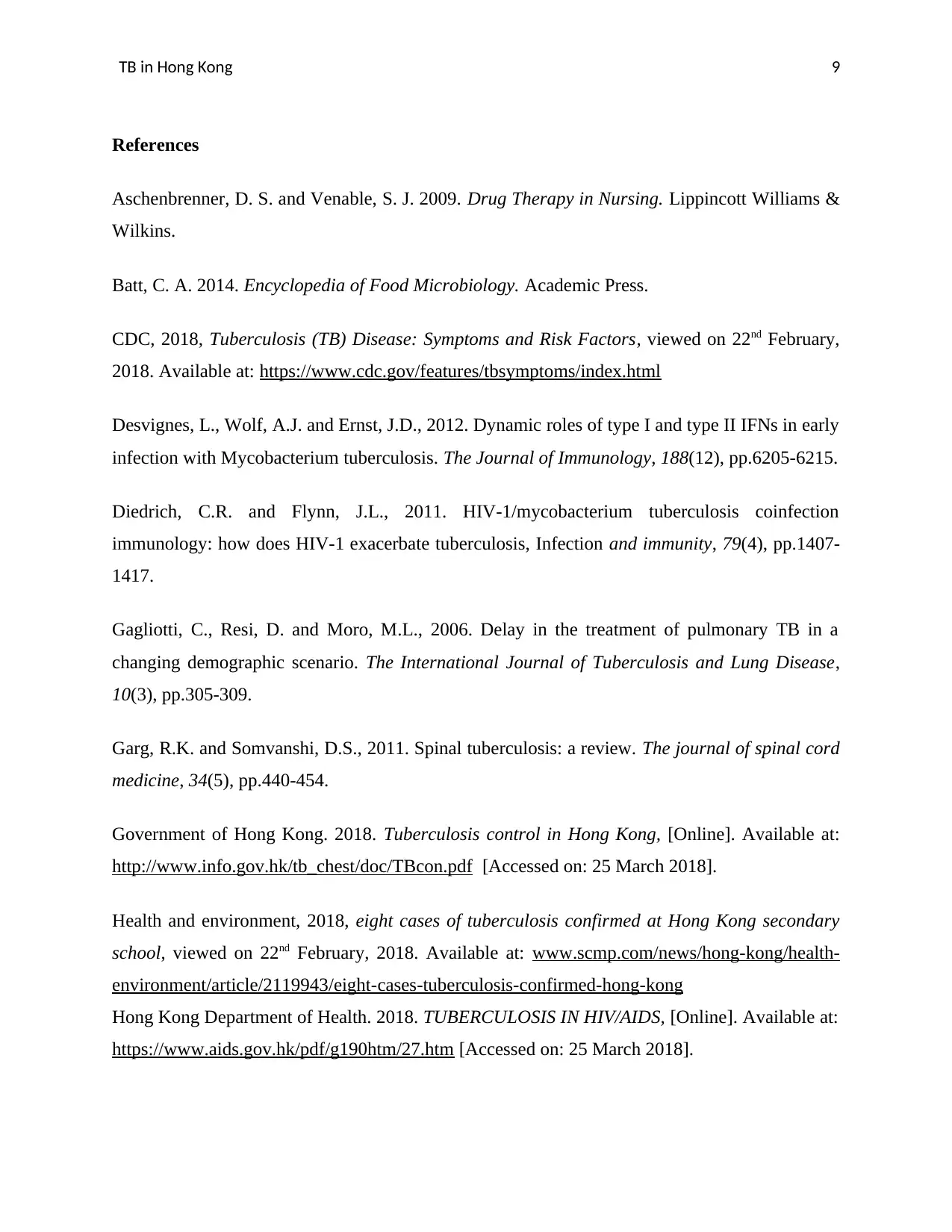
TB in Hong Kong 9
References
Aschenbrenner, D. S. and Venable, S. J. 2009. Drug Therapy in Nursing. Lippincott Williams &
Wilkins.
Batt, C. A. 2014. Encyclopedia of Food Microbiology. Academic Press.
CDC, 2018, Tuberculosis (TB) Disease: Symptoms and Risk Factors, viewed on 22nd February,
2018. Available at: https://www.cdc.gov/features/tbsymptoms/index.html
Desvignes, L., Wolf, A.J. and Ernst, J.D., 2012. Dynamic roles of type I and type II IFNs in early
infection with Mycobacterium tuberculosis. The Journal of Immunology, 188(12), pp.6205-6215.
Diedrich, C.R. and Flynn, J.L., 2011. HIV-1/mycobacterium tuberculosis coinfection
immunology: how does HIV-1 exacerbate tuberculosis, Infection and immunity, 79(4), pp.1407-
1417.
Gagliotti, C., Resi, D. and Moro, M.L., 2006. Delay in the treatment of pulmonary TB in a
changing demographic scenario. The International Journal of Tuberculosis and Lung Disease,
10(3), pp.305-309.
Garg, R.K. and Somvanshi, D.S., 2011. Spinal tuberculosis: a review. The journal of spinal cord
medicine, 34(5), pp.440-454.
Government of Hong Kong. 2018. Tuberculosis control in Hong Kong, [Online]. Available at:
http://www.info.gov.hk/tb_chest/doc/TBcon.pdf [Accessed on: 25 March 2018].
Health and environment, 2018, eight cases of tuberculosis confirmed at Hong Kong secondary
school, viewed on 22nd February, 2018. Available at: www.scmp.com/news/hong-kong/health-
environment/article/2119943/eight-cases-tuberculosis-confirmed-hong-kong
Hong Kong Department of Health. 2018. TUBERCULOSIS IN HIV/AIDS, [Online]. Available at:
https://www.aids.gov.hk/pdf/g190htm/27.htm [Accessed on: 25 March 2018].
References
Aschenbrenner, D. S. and Venable, S. J. 2009. Drug Therapy in Nursing. Lippincott Williams &
Wilkins.
Batt, C. A. 2014. Encyclopedia of Food Microbiology. Academic Press.
CDC, 2018, Tuberculosis (TB) Disease: Symptoms and Risk Factors, viewed on 22nd February,
2018. Available at: https://www.cdc.gov/features/tbsymptoms/index.html
Desvignes, L., Wolf, A.J. and Ernst, J.D., 2012. Dynamic roles of type I and type II IFNs in early
infection with Mycobacterium tuberculosis. The Journal of Immunology, 188(12), pp.6205-6215.
Diedrich, C.R. and Flynn, J.L., 2011. HIV-1/mycobacterium tuberculosis coinfection
immunology: how does HIV-1 exacerbate tuberculosis, Infection and immunity, 79(4), pp.1407-
1417.
Gagliotti, C., Resi, D. and Moro, M.L., 2006. Delay in the treatment of pulmonary TB in a
changing demographic scenario. The International Journal of Tuberculosis and Lung Disease,
10(3), pp.305-309.
Garg, R.K. and Somvanshi, D.S., 2011. Spinal tuberculosis: a review. The journal of spinal cord
medicine, 34(5), pp.440-454.
Government of Hong Kong. 2018. Tuberculosis control in Hong Kong, [Online]. Available at:
http://www.info.gov.hk/tb_chest/doc/TBcon.pdf [Accessed on: 25 March 2018].
Health and environment, 2018, eight cases of tuberculosis confirmed at Hong Kong secondary
school, viewed on 22nd February, 2018. Available at: www.scmp.com/news/hong-kong/health-
environment/article/2119943/eight-cases-tuberculosis-confirmed-hong-kong
Hong Kong Department of Health. 2018. TUBERCULOSIS IN HIV/AIDS, [Online]. Available at:
https://www.aids.gov.hk/pdf/g190htm/27.htm [Accessed on: 25 March 2018].
Secure Best Marks with AI Grader
Need help grading? Try our AI Grader for instant feedback on your assignments.
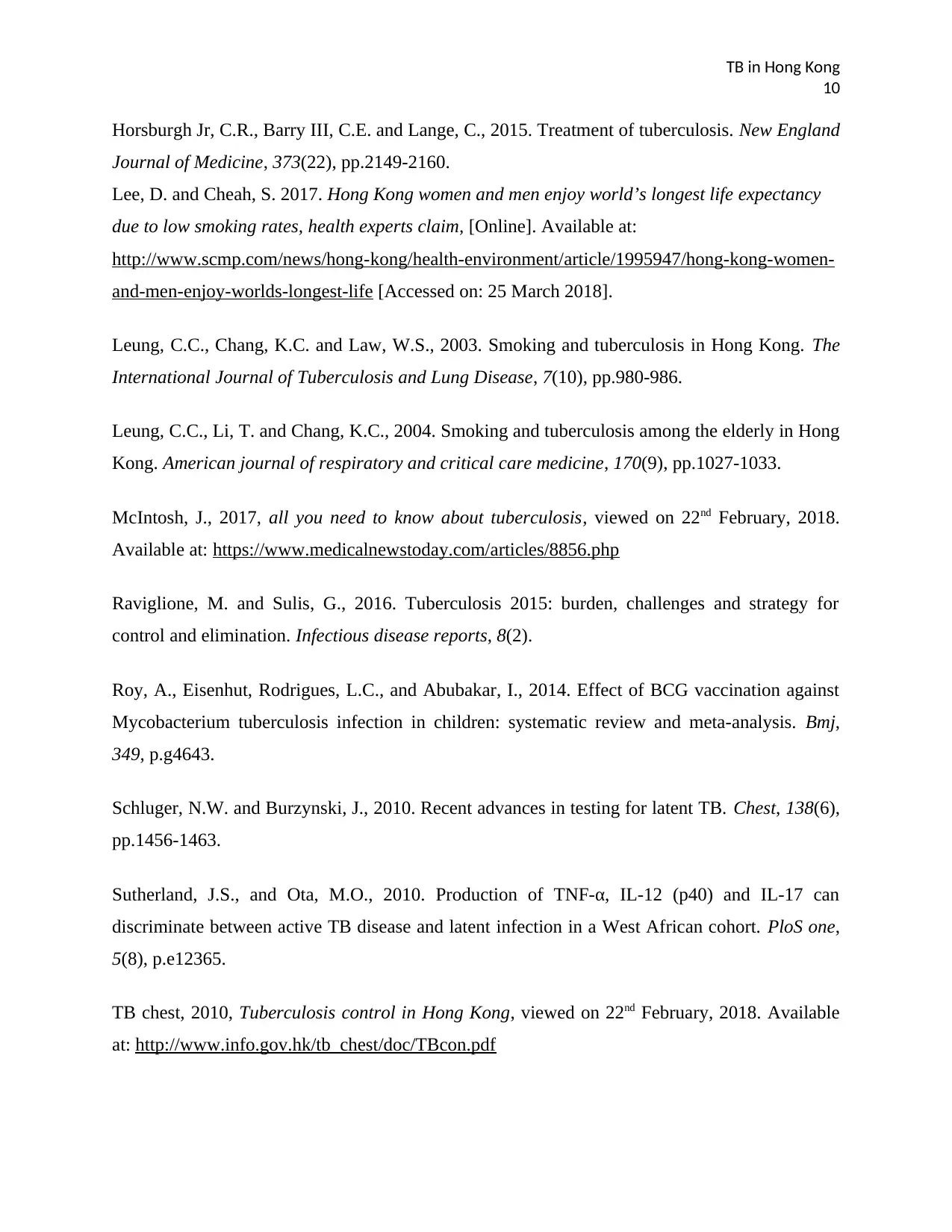
TB in Hong Kong
10
Horsburgh Jr, C.R., Barry III, C.E. and Lange, C., 2015. Treatment of tuberculosis. New England
Journal of Medicine, 373(22), pp.2149-2160.
Lee, D. and Cheah, S. 2017. Hong Kong women and men enjoy world’s longest life expectancy
due to low smoking rates, health experts claim, [Online]. Available at:
http://www.scmp.com/news/hong-kong/health-environment/article/1995947/hong-kong-women-
and-men-enjoy-worlds-longest-life [Accessed on: 25 March 2018].
Leung, C.C., Chang, K.C. and Law, W.S., 2003. Smoking and tuberculosis in Hong Kong. The
International Journal of Tuberculosis and Lung Disease, 7(10), pp.980-986.
Leung, C.C., Li, T. and Chang, K.C., 2004. Smoking and tuberculosis among the elderly in Hong
Kong. American journal of respiratory and critical care medicine, 170(9), pp.1027-1033.
McIntosh, J., 2017, all you need to know about tuberculosis, viewed on 22nd February, 2018.
Available at: https://www.medicalnewstoday.com/articles/8856.php
Raviglione, M. and Sulis, G., 2016. Tuberculosis 2015: burden, challenges and strategy for
control and elimination. Infectious disease reports, 8(2).
Roy, A., Eisenhut, Rodrigues, L.C., and Abubakar, I., 2014. Effect of BCG vaccination against
Mycobacterium tuberculosis infection in children: systematic review and meta-analysis. Bmj,
349, p.g4643.
Schluger, N.W. and Burzynski, J., 2010. Recent advances in testing for latent TB. Chest, 138(6),
pp.1456-1463.
Sutherland, J.S., and Ota, M.O., 2010. Production of TNF-α, IL-12 (p40) and IL-17 can
discriminate between active TB disease and latent infection in a West African cohort. PloS one,
5(8), p.e12365.
TB chest, 2010, Tuberculosis control in Hong Kong, viewed on 22nd February, 2018. Available
at: http://www.info.gov.hk/tb_chest/doc/TBcon.pdf
10
Horsburgh Jr, C.R., Barry III, C.E. and Lange, C., 2015. Treatment of tuberculosis. New England
Journal of Medicine, 373(22), pp.2149-2160.
Lee, D. and Cheah, S. 2017. Hong Kong women and men enjoy world’s longest life expectancy
due to low smoking rates, health experts claim, [Online]. Available at:
http://www.scmp.com/news/hong-kong/health-environment/article/1995947/hong-kong-women-
and-men-enjoy-worlds-longest-life [Accessed on: 25 March 2018].
Leung, C.C., Chang, K.C. and Law, W.S., 2003. Smoking and tuberculosis in Hong Kong. The
International Journal of Tuberculosis and Lung Disease, 7(10), pp.980-986.
Leung, C.C., Li, T. and Chang, K.C., 2004. Smoking and tuberculosis among the elderly in Hong
Kong. American journal of respiratory and critical care medicine, 170(9), pp.1027-1033.
McIntosh, J., 2017, all you need to know about tuberculosis, viewed on 22nd February, 2018.
Available at: https://www.medicalnewstoday.com/articles/8856.php
Raviglione, M. and Sulis, G., 2016. Tuberculosis 2015: burden, challenges and strategy for
control and elimination. Infectious disease reports, 8(2).
Roy, A., Eisenhut, Rodrigues, L.C., and Abubakar, I., 2014. Effect of BCG vaccination against
Mycobacterium tuberculosis infection in children: systematic review and meta-analysis. Bmj,
349, p.g4643.
Schluger, N.W. and Burzynski, J., 2010. Recent advances in testing for latent TB. Chest, 138(6),
pp.1456-1463.
Sutherland, J.S., and Ota, M.O., 2010. Production of TNF-α, IL-12 (p40) and IL-17 can
discriminate between active TB disease and latent infection in a West African cohort. PloS one,
5(8), p.e12365.
TB chest, 2010, Tuberculosis control in Hong Kong, viewed on 22nd February, 2018. Available
at: http://www.info.gov.hk/tb_chest/doc/TBcon.pdf
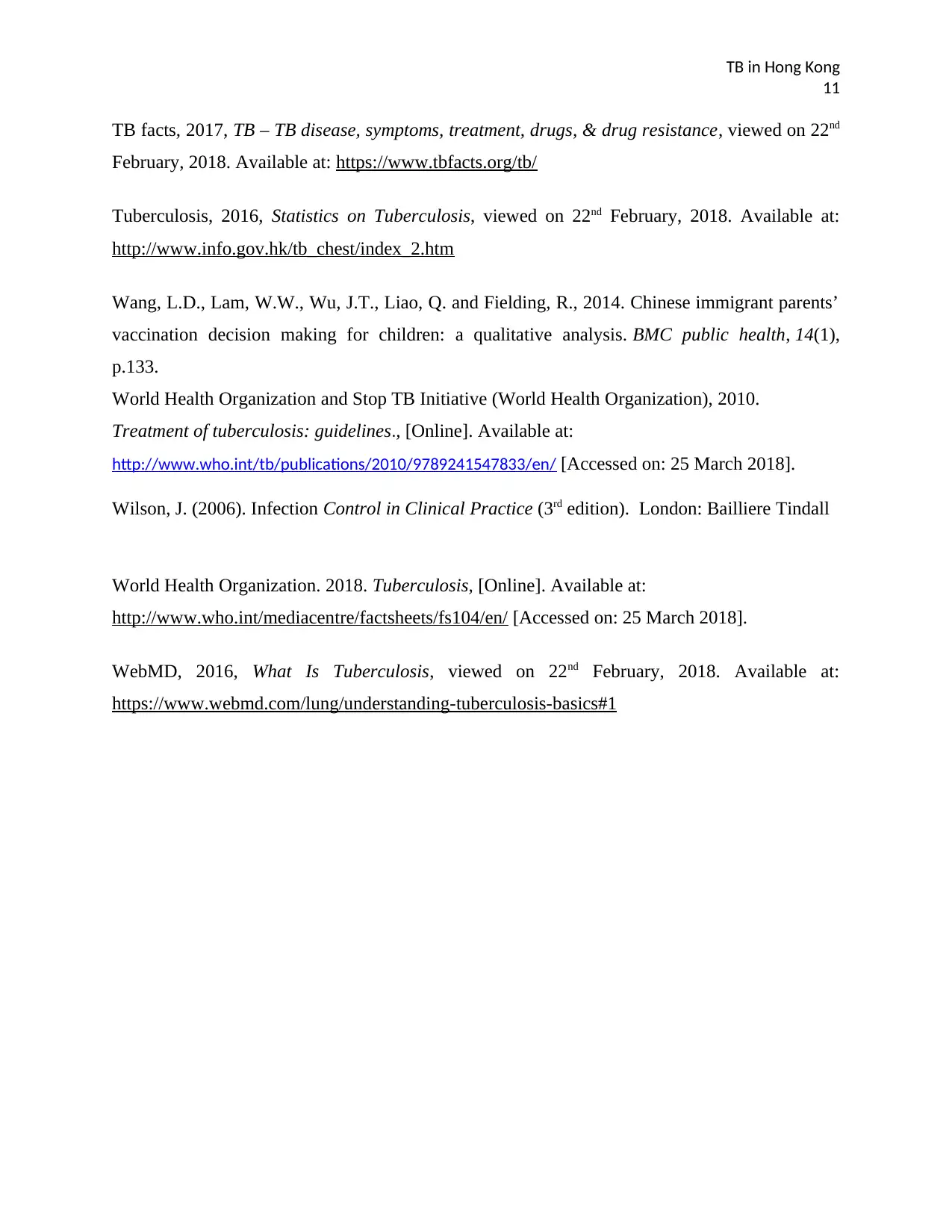
TB in Hong Kong
11
TB facts, 2017, TB – TB disease, symptoms, treatment, drugs, & drug resistance, viewed on 22nd
February, 2018. Available at: https://www.tbfacts.org/tb/
Tuberculosis, 2016, Statistics on Tuberculosis, viewed on 22nd February, 2018. Available at:
http://www.info.gov.hk/tb_chest/index_2.htm
Wang, L.D., Lam, W.W., Wu, J.T., Liao, Q. and Fielding, R., 2014. Chinese immigrant parents’
vaccination decision making for children: a qualitative analysis. BMC public health, 14(1),
p.133.
World Health Organization and Stop TB Initiative (World Health Organization), 2010.
Treatment of tuberculosis: guidelines., [Online]. Available at:
http://www.who.int/tb/publications/2010/9789241547833/en/ [Accessed on: 25 March 2018].
Wilson, J. (2006). Infection Control in Clinical Practice (3rd edition). London: Bailliere Tindall
World Health Organization. 2018. Tuberculosis, [Online]. Available at:
http://www.who.int/mediacentre/factsheets/fs104/en/ [Accessed on: 25 March 2018].
WebMD, 2016, What Is Tuberculosis, viewed on 22nd February, 2018. Available at:
https://www.webmd.com/lung/understanding-tuberculosis-basics#1
11
TB facts, 2017, TB – TB disease, symptoms, treatment, drugs, & drug resistance, viewed on 22nd
February, 2018. Available at: https://www.tbfacts.org/tb/
Tuberculosis, 2016, Statistics on Tuberculosis, viewed on 22nd February, 2018. Available at:
http://www.info.gov.hk/tb_chest/index_2.htm
Wang, L.D., Lam, W.W., Wu, J.T., Liao, Q. and Fielding, R., 2014. Chinese immigrant parents’
vaccination decision making for children: a qualitative analysis. BMC public health, 14(1),
p.133.
World Health Organization and Stop TB Initiative (World Health Organization), 2010.
Treatment of tuberculosis: guidelines., [Online]. Available at:
http://www.who.int/tb/publications/2010/9789241547833/en/ [Accessed on: 25 March 2018].
Wilson, J. (2006). Infection Control in Clinical Practice (3rd edition). London: Bailliere Tindall
World Health Organization. 2018. Tuberculosis, [Online]. Available at:
http://www.who.int/mediacentre/factsheets/fs104/en/ [Accessed on: 25 March 2018].
WebMD, 2016, What Is Tuberculosis, viewed on 22nd February, 2018. Available at:
https://www.webmd.com/lung/understanding-tuberculosis-basics#1
1 out of 12
Related Documents
Your All-in-One AI-Powered Toolkit for Academic Success.
+13062052269
info@desklib.com
Available 24*7 on WhatsApp / Email
![[object Object]](/_next/static/media/star-bottom.7253800d.svg)
Unlock your academic potential
© 2024 | Zucol Services PVT LTD | All rights reserved.





